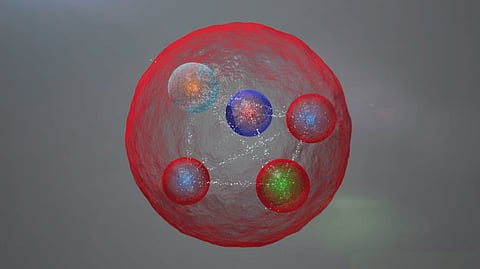
- Home
- न्यूजग्राम
- India
- World
- Politics
- Entertainment
- Culture
- Lifestyle
- Economy
- Sports
- Sp. Coverage
- Misc.
- NewsGram Exclusive
- Jobs / Internships

By NewsGram Staff Writer
Pentaquark, the world's most powerful particle smasher – whose existence had been clandestine since 1960's has been finally discovered by the scientists at Large Hardon Collider in Switzerland on Tuesday.
Physicists conceded its existence since the 1960's but they failed in detecting the same until the recent discovery.
Considered as a powerful particle smasher, Pentaquark comes second after the discovery of Higgs Boson – which confers mass – by LHC in the year 2012.
According to LHCb spokesman Guy Wilkinson, the Pentaquark represents a way to blend quarks, which includes sub-atomic particles that make up protons and neutrons in a pattern that hasn't been observed yet in a stint of 50 years of experimentation.
Reading into its properties would also allow scientists to understand how ordinary matter – which includes protons and neutrons – is constituted, he added.
After a two – year upgrade, LHC has got back on its feet, with scientists paving a new era in their quest to unearth more mysteries of the universe.
The LHCb – one of the four experiments – is focused on understanding the differences between matter and anti-matter.
According to CERN (European Organisation for Nuclear Research), one's understanding of the structure of matter was given a new light in the year 1964 when American physicist Murray Gell – Mann – a Nobel Prize Winner – proposed that a category of particles known as baryons are comprised of three fractionally charged objects called quarks.
The Nobel laureate had further proposed another category of particles known as mesons – comprised of quark-anti-quark pairs. His model provided space for the existence of other quark combinations such as Pentaquarks, which are formed of four quarks and an anti-quark; however there was no evidence to prove the existence of Pentaquarks.
The LHCb experiment has introduced scientists to varied ways in which they can understand and study Pentaquarks, which wasn't possible till now, CERN added.
The recent findings have been submitted to the Physical Review Journal.
The next stage of the research will focus on studying how the quarks are bound together within the Pentaquarks, the nuclear laboratory.
